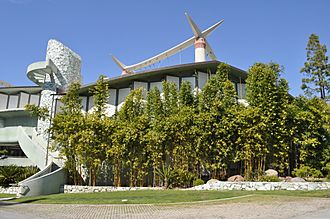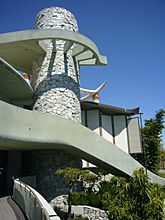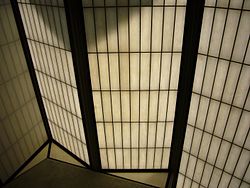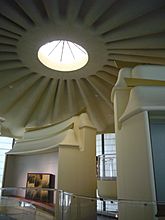Pavilion for Japanese Art facts for kids
Quick facts for kids Pavilion for Japanese Art |
|
|---|---|

Pavilion for Japanese Art at the Los Angeles County Museum of Art
|
|
| General information | |
| Type | Art Museum |
| Architectural style | Expressionism, New Modernism |
| Location | Los Angeles |
| Construction started | 1978 |
| Completed | 1988 |
| Design and construction | |
| Architect | Bruce Goff (completed by Bart Prince after Goff's death) |
The Pavilion for Japanese Art is a special building at the Los Angeles County Museum of Art (LACMA). It holds an amazing collection of Japanese art from ancient times (around 3000 BC) all the way up to the 1900s. A famous architect named Bruce Goff designed this unique building.
Contents
What Art Can You See?
The Pavilion has many different types of Japanese art. You can see old archaeological items and beautiful sculptures. There are also pieces related to Buddhism and Shinto, which are important Japanese religions.
Art on the Second Level
On the second floor of the Pavilion's West Wing, you'll find many cool things. These include ceramics, shiny lacquerware, and colorful textiles. There are also items made with cloisonné (a special enamel technique) and even armor.
The Helen and Felix Juda Gallery is also on the second floor. This gallery often shows different Japanese prints. These are usually traditional woodblock prints from the Edo period (1615–1868). You can also see prints from later times like the Meiji period (1868–1912) and Shōwa period (1926–1989). The print exhibits change every three months. They might focus on different time periods, themes, or art styles.
Art in the East Wing
The East Wing of the Pavilion has a changing display of screens and hanging scrolls. These artworks are mostly from the Edo period. You might see art from famous schools like Rimpa and ukiyo-e. There are also spontaneous drawings made by Zen monks. This part of the museum has art displayed on six different levels.
The Netsuke Gallery
On the main floor, there's the Raymond and Frances Bushell Netsuke Gallery. This gallery has a huge collection of 827 netsuke. Netsuke are tiny, detailed sculptures made between the 1600s and 1900s. You can walk all around the gallery to see these miniature artworks from every angle. In old Japan, men used netsuke as toggles. They would hang things like tobacco pouches or small cases (called inro) from their kimono sashes.
How the Building Was Designed
The Pavilion for Japanese Art was designed by Bruce Goff. It's about 32,100 square feet in size. The building is special because it has translucent (see-through) fiberglass panels. These panels let soft, natural sunlight into the museum. This is important because it helps protect the paintings.
The natural light also makes the art look better. It's similar to how these paintings were originally viewed. For example, gold leaf on the art can reflect the light. This creates a cool 3D effect that you might not see with artificial lights. Large Japanese screens can be viewed from a distance. Scrolls can be seen up close in small, cozy areas. These areas are like the tokonoma viewing spaces in Japanese homes. The building also has a unique roof shaped like the front of a ship and round towers. The outdoor areas around the building were designed by Hannah Olin's firm.
History of the Pavilion
The museum's Japanese art collection started with Joe D. Price. He was a collector who owned over 300 Japanese scroll and screen paintings. In 1983, Mr. Price and his wife, Etsuko Yoshimochi, gave about 300 of these artworks to LACMA. They also donated $5 million to help build a special place for them.
In 1987, Mr. Price also joined LACMA's board. The museum agreed to take care of and show the collection. They also promised to raise more money for the building. LACMA actually raised $7.5 million, which was more than they planned! Bruce Goff's original design for the Pavilion was first meant for Oklahoma. Then, it was going to be a part of the Metropolitan Museum of Art in New York. But finally, it became a part of LACMA. Bruce Goff's former helper, Bart Prince, helped turn Goff's ideas into building plans for LACMA. The total cost to build the Pavilion was $13 million.
The Pavilion for Japanese Art is part of a bigger plan to update the LACMA campus. Architect Peter Zumthor is leading this redesign.
Photo gallery
External links
ca:Museu d'Art del Comtat de Los Angeles de:Los Angeles County Museum of Art
fr:Musée d'art du comté de Los Angeles





